This article is the fourth in a series of articles about known members of the 32nd Station Hospital during World War II. This list is based largely on rosters dated December 31, 1943, May 1, 1944, and December 31, 1944. These articles are due for overhaul based on new information that came to light from the unit’s morning reports.
World War II U.S. Army officers’ service numbers were in two formats (sometimes in the same report!): With an officer prefix and hyphen (O-______) or with no prefix and a leading zero (0______). Though the latter format was technically accurate from 1942 onward, for simplicity I have used the first format, which I find clearer and less subject to confusion with enlisted service numbers.
Names are listed in alphabetical order within the 32nd Station Hospital’s Medical Service.
William Alfred Carey, Jr., O-461173 (December 17, 1915 – August 27, 2002)
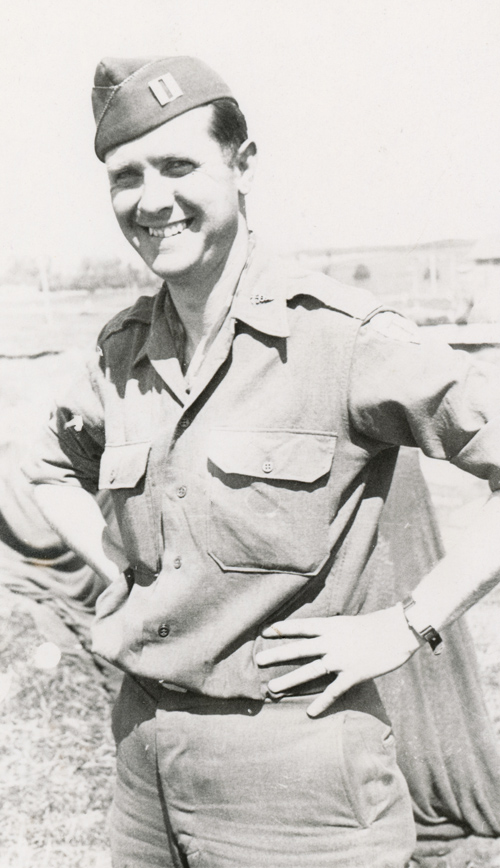
Dr. Carey was born in Quincy, Massachusetts, the son of William Alfred Carey, Sr. and Mary Ellen (Coughlin) Carey. He graduated from the Yale School of Medicine in 1941, followed by an internship at St. Louis University Hospital. He entered active duty in the U.S. Army on July 1, 1942. According to the notes Dr. Carey kept about his service, his first posting was at Carlisle Barracks (one of the U.S. Army’s medical training facilities). He was then was stationed at Barksdale Field in Louisiana.
Dr. Carey was assigned to the 32nd Station Hospital at Camp Rucker, Alabama on August 7, 1942. Dr. Carey’s son recalls his father telling about how he got off the train at a poorly marked siding in the middle of nowhere, organized some bewildered enlisted men who were waiting for instructions, and set off to find the camp! On November 10, 1943, word arrived in Tlemcen, Algeria from Headquarters, North African Theatre of Operations, United States Army, that Carey had been promoted to captain, effective November 1.
By December 31, 1943, he was listed as Dispensary Surgeon, Admission, and Disposition Officer. By May 1, 1944, that role had been assumed by Lieutenant Colonel John F. Simon; Captain Carey’s new title was Ward Officer – General Medicine.
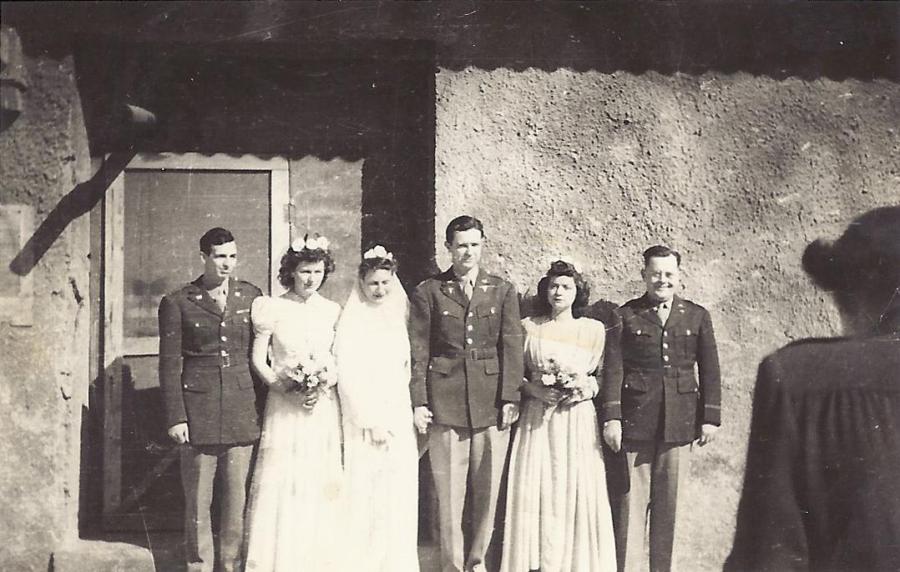
Dr. Carey married his wife Ina L. Bean (sometimes spelled Beane)—a 32nd Station Hospital nurse—on March 29, 1944 at St. Mary of Angela (Santa Maria degli Angeli), a Catholic church located in the village of San Nicola la Strada near the hospital compound.
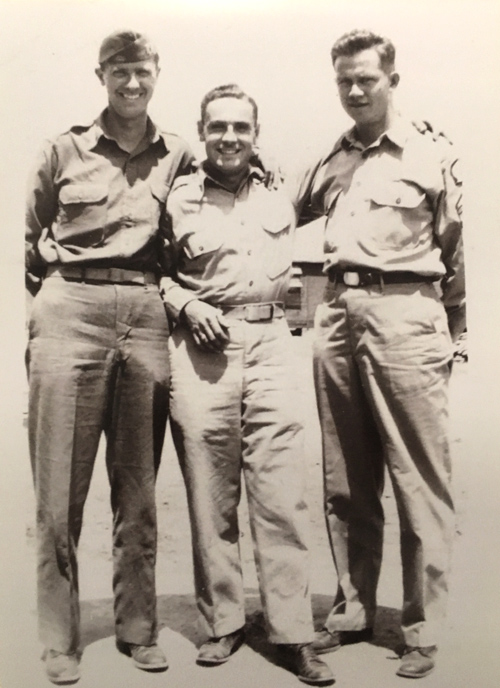
A document in Dr. Carey’s collection, Peninsular Base Section Special Orders Number 151 (dated May 30, 1944) indicates that Captain Carey was reassigned to Headquarters, 36th Infantry Division. He left the unit on June 3, 1944. He participated in the Southern France, Rhineland, and Central Europe campaigns. On December 31, 1944 he assumed command of Company B, 111th Medical Battalion of the 36th Infantry Division.
Captain Carey was decorated with the Bronze Star Medal for his service with the 36th Infantry Division. The citation for the medal—dated January 17, 1945 and signed by Major General John E. Dahlquist—states:
WILLIAM A. CAREY, JR., 0461173, Captain, 111th Medical Battalion, for meritorious service in direct support of combat operations from 4 June to 31 December 1944 in Italy and France. During this period, Captain Carey distinguished himself by his skill and courage in performing his duties as surgeon with the Division. He consistently rendered superior medical treatment under the most difficult combat conditions. His aid station was sometimes established in mountain caves, ditches, open fields and shallow beachheads. He frequently worked under small arms, mortar and artillery fire. In spite of all the difficulties and dangers which confronted him, Captain Carey always assured the droops of prompt treatment and evacuation. As a result of his tireless efforts, the lives of many soldiers were saved, and his outstanding work inspired the respect and confidence of everyone with whom he came in contact. Entered the Service from Quincy, Massachusetts.
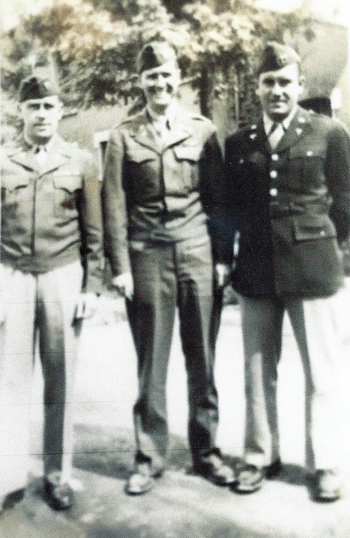
Dr. Carey later mentioned to his daughter that during his service with the 36th Infantry Division, he was deeply affected when he witnessed the horrors of a Nazi concentration camp. This would most likely have been some of the Kaufering subcamps—part of the infamous Dachau concentration camp—which, according to the United States Holocaust Memorial Museum website, the 36th Infantry Division liberated on April 30, 1945. Although he left active duty on January 9, 1946 (according to his Department of Veterans Affairs Record), he remained as an officer in the U.S. Army Reserve. He was promoted to major on February 10, 1947.

After the war, Dr. Carey completed additional medical training and became a radiologist. He practiced at a number of Massachusetts hospitals: St. Elizabeth’s Hospital in Boston (1948–1964), St. Vincent’s Hospital in Worcester (1964–1977), Fallon Clinic in Worcester (1977–1987), and Bethany Hospital in Framingham (1951–1987). In 1950, the Careys moved to Framingham, where they raised a daughter and three sons. Their marriage lasted just shy of 58 years, until Ina’s death on December 30, 2001, aged 81. William died on August 27, 2002, aged 86.
Marlin W. Carlson, O-339610 (August 6, 1905 – October 25, 1963)
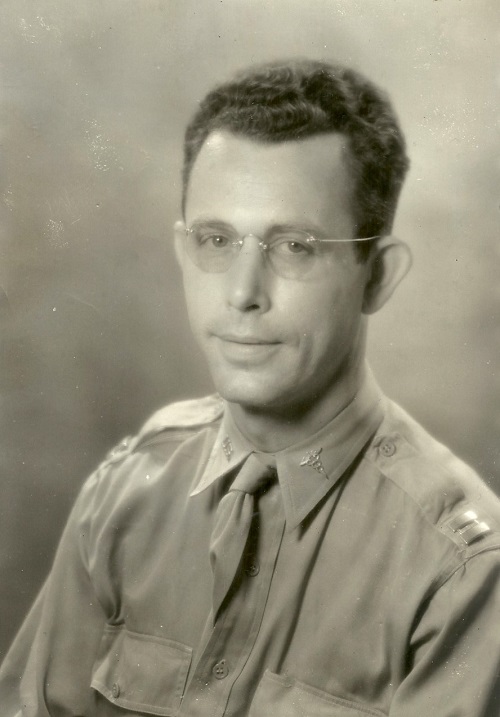
Dr. Carlson was born and lived in Kansas. He attended McPherson College and studied medicine at Northwestern University.
Captain Carlson joined the 32nd Station Hospital at Fort Benning, Georgia on November 26, 1942. His title was Assistant Chief of Service – Respiratory Disease and Internal Medicine on the roster dated December 31, 1943. He was promoted to major on April 17, 1944. By May 1, 1944 his title was Assistant Chief of [Medical] Service. On the December 31, 1944 roster he was listed with his original title. In May 1945, he was returned to the United States on temporary duty for “rehabilitation recuperation and recovery purposes.” It doesn’t appear that he rejoined the unit before it was deactivated.
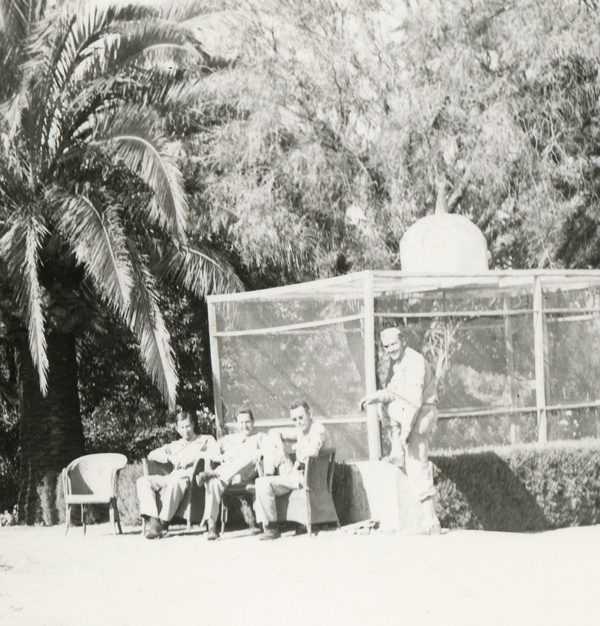
Dr. Carlson eventually attained the rank of lieutenant colonel at some point prior to leaving the army. He and his wife Anne had a son and a daughter. He died in Ellinwood, Kansas, aged 58.
James Gilbert Eblen, O-1696551 (October 25, 1906 – August 24, 1957)

Captain Eblen was already a member of the 32nd Station Hospital by November 2, 1942 when he was listed on Hospital Order Number 15. He was listed as Ward Officer – Contagious Diseases as of December 31, 1943, as well as both 1944 rosters. Captain Eblen remained in the unit even after most of its longstanding personnel transferred out; on July 21, 1945 he became Assistant Chief of Medical Service, though the hospital was not in operation at this time and would not resume service before being deactivated. Upon the unit’s arrival at the Boston Port of Embarkation aboard the S.S. John Clarke on October 8, 1945, he was transferred to the Reception Station at Camp Myles Standish, Massachusetts.
When this article was first published, I wrote that I was unable to learn anything else about this doctor. In March 2019, Dr. William A. Carey and nurse Ina Bean Carey’s son passed along an image of a program from a 32nd Station Hospital Thanksgiving celebration in 1943. Unlike my grandfather’s copy, the Carey copy was signed by several officers, including one listed as Gilbert Eblen. It seemed likely that Dr. Eblen went by his middle name. Indeed, I quickly found a death certificate for a J. Gilbert Eblen, a physician and World War II veteran from Knoxville, Tennessee who died in Sylva, North Carolina, aged 50.
James Gilbert Eblen was born and raised in Lenoir City, Tennessee, the son of Dr. James Gustavus Eblen (which may explain why he went by his middle name, since his father was also Dr. James Eblen) and Nancy “Janie” Eblen. A James G. Eblen appeared on a 1929 Memphis, Tennessee directory listed as a student; indeed, his obituary in The Jackson Sun (Jackson, Tennessee) lists him as graduating from the University of Tennessee Medical College there in 1930.
By the time of the 1940 census, a Gilbert Eblen listed as a pediatrician was living with his wife Louise (1912– 2002) and his in-laws in Knoxville. Dr. J. Gilbert Eblen was listed on a 1942 Knoxville directory as working at Smith-Eblen Clinic for Children. Interestingly, it appears that the 32nd Station Hospital’s medical officers included three pediatricians at the same time: Dr. Eblen, Dr. Robert O.Y. Warren, and Dr. Joseph Dolgin. Dr. Eblen’s obituary describes him as a “Knoxville pediatrician and president of the Knoxville Academy of Medicine” who died of a sudden illness while on vacation in North Carolina. I initially was unable to find a record of Dr. Eblen and his wife having children. I contacted another user on Ancestry.com who had him in listed in a family tree. For the record, she thought Dr. Eblen was her “paternal 1st cousin of wife of 2nd cousin 3x removed.” Isn’t the internet grand? (As it turned out, upon further examination prompted by my inquiry, she determined that she was related to a different Amos Breazeale than the one Dr. Eblen was related to, so she wasn’t related to him at all. Still, a fortuitous error for this project.)
Anyway, this Ancestry.com user pointed out a pair of 1956 documents (regarding a trip to Great Britain aboard the R.M.S. Queen Elizabeth) that I had overlooked, which suggested the Eblens had a daughter. I was able to confirm that the Eblens had a daughter and that he indeed was one of three pediatricians in the unit.
George Francis Evans, O-488984 (June 14, 1900 – August 25, 1976)
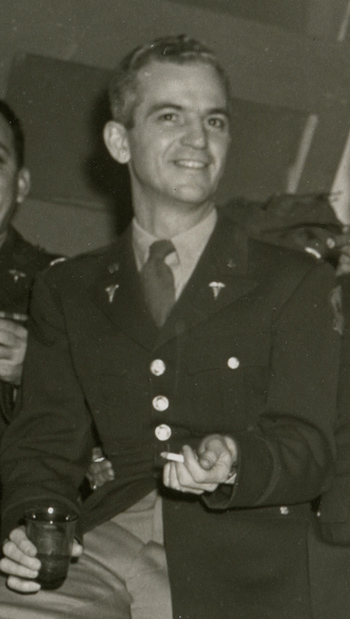
Dr. Evans was born in Ontario but later moved to the United States and became a U.S. citizen. Dr. Evans eventually settled in Clarksburg, West Virginia in 1934 and practiced as an internist there. He married his wife Elah (1907–2004) in 1936; I have been unable to locate any record of the couple having children. His draft card dated February 16, 1942 listed him as being 5 feet, 9 inches (175 cm) tall and 160 lbs. (72.6 kg), with gray hair and brown eyes.
Dr. Evans entered the U.S. Army on August 25, 1942. He joined the 32nd Station Hospital from the 29th Station Hospital in August 1944, replacing Lt. Colonel Robert O.Y. Warren as Chief of Service – Internal Medicine. Dr. Evans was promoted to lieutenant colonel as of December 25, 1944. In his journal, Captain Lowell E. Vinsant described Lieutenant Colonel Evans (apparently without irony, but not definitely) as “a prince of a fellow”.
In May 1945, he visited Cairo and the pyramids with my grandfather, Captain Robert Silverman. Lieutenant Colonel Evans was decorated with the Bronze Star sometime in 1945. He left the unit in July 1945.
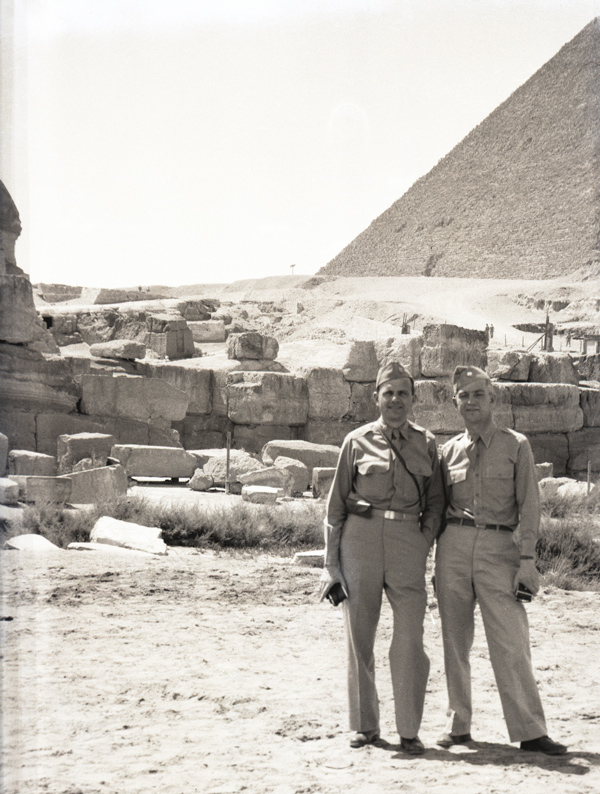
After the war, he returned to Clarksburg. He served on the West Virginia Medical Licensing Board (1946–1966), was president of the West Virginia State Medical Association (1958–1959) and editor of the West Virginia Medical Journal (1962–197?). He died in Clarksburg, aged 76.
Richard Toshio Kainuma, O-418692 (August 31, 1911 – September 3, 1965)
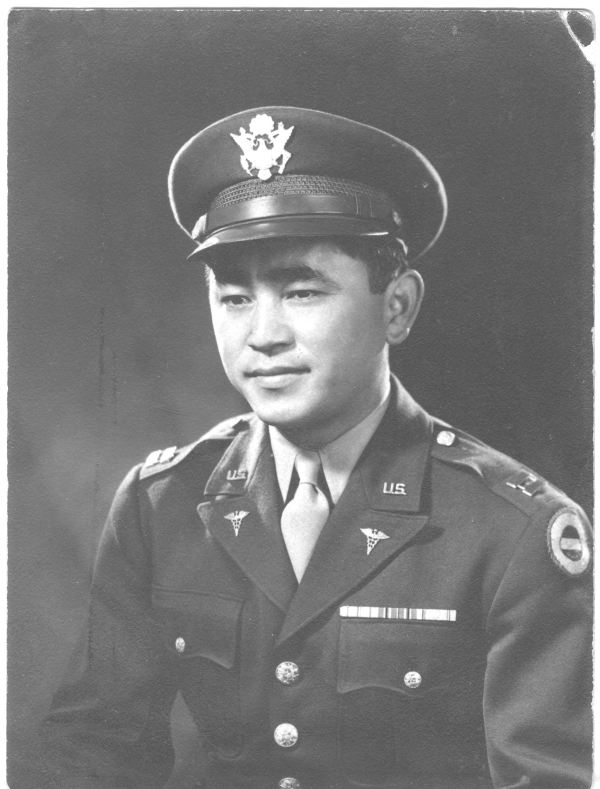
Dr. Kainuma was born in Hawaii and graduated from Tulane University Medical School in 1938. He joined the U.S. Army in May 1941 and was assigned to the predominantly Nisei 100th Infantry Battalion. He later joined the 32nd Station Hospital from the 7th Replacement Depot on April 11, 1944. On the May 1, 1944 roster, Captain Kainuma was listed as Ward Officer – General Medicine. He departed the unit on September 15, 1944 to return to the United States via the 7th Replacement Depot.
After returning to civilian life, Dr. Kainuma resumed his medical practice in Hawaii. Dr. Kainuma and his wife Mildred had one son.
A short biography of Dr. Kainuma by Michael Markrich is posted on the 100th Infantry Battalion Veterans Educational Center website.
George Raymond Lee, O-209450 (October 2, 1899 – November 12, 1964)
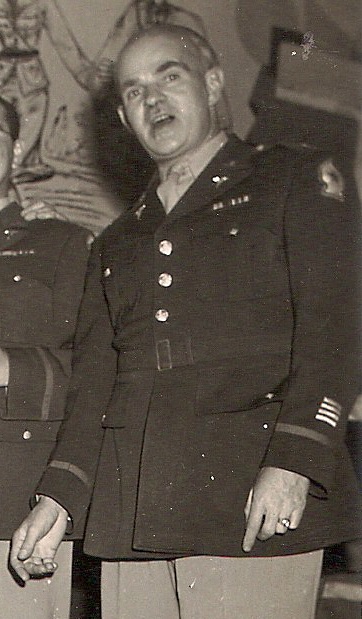
Dr. Lee was born in Toronto, Kansas. By September 1918 he was attending St. Louis University School of Medicine, but his daughter wrote that he eventually graduated from the University of Kansas School of Medicine in 1924. After his residency at Bell Memorial Hospital, Dr. Lee worked as a general practitioner in Yates Center, Kansas. His February 16, 1942 draft card lists him as 5 feet, 9 inches (175 cm) and 165 lbs. (75 kg), with brown hair and gray eyes.
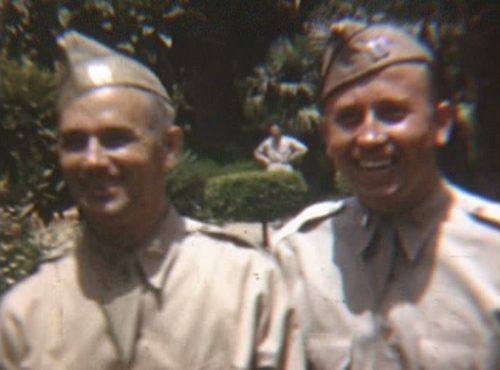
Captain Lee was assigned to the 32nd Station Hospital per a War Department special order dated September 16, 1942 and joined the unit on September 25, 1942 at at Camp Rucker, Alabama. Captain Lee became the unit’s Lab Officer on August 15, 1943. Captain Lee was listed as Ward Officer – Tropical Medicine and Dermatology as of December 31, 1943. The May 1, 1944 roster drops the dermatology part but his title is back to the full one on the December 31, 1944 roster. Captain Lee apparently served as the unit’s Soldier Voting Officer for the election of 1944. He was awarded the Bronze Star Medal sometime in 1945. Like many longstanding members of the 32nd Station Hospital, he left the unit in July 1945, but was transferred back that same summer. Upon the unit’s arrival at the Boston Port of Embarkation aboard the S.S. John Clarke on October 8, 1945, he was transferred to the Reception Station at Camp Myles Standish, Massachusetts. He had four daughters: two with his first wife Thelma, and two with his second wife, Lenora.
Louis Linn, O-1689060 (May 14, 1914 – September 3, 2009)
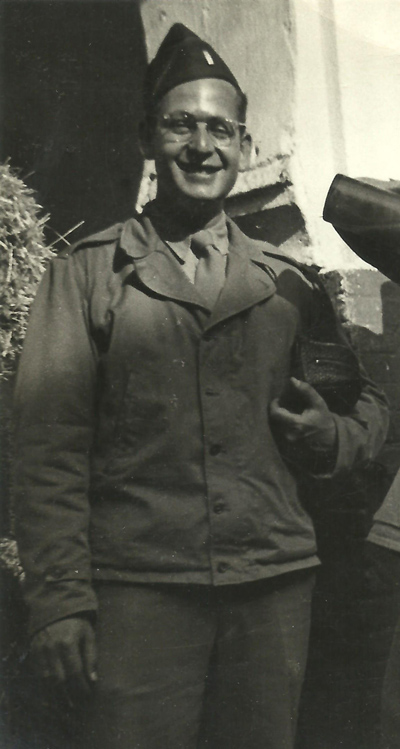
Dr. Linn was born in Newark, New Jersey to Abraham and Anna Linn, Jewish immigrants from Russia. His brothers and sisters helped put him through medical school. He married Miriam Louise Wechsler (1919–2007) in 1941. His first child, a daughter, was born in 1943 while he was overseas during World War II. The Linns also had a son after the war.
1st Lieutenant Linn joined the 32nd Station Hospital on August 16, 1942. Dr. Linn’s service with the 32nd Station Hospital is particularly well documented thanks to his letter to Willard Havemeier dated July 29, 1998, which Havemeier uploaded to his website.

According to his letter, Dr. Linn joined the U.S. Army in New York City. He was first stationed at O’Reilly General Hospital, Springfield Missouri. Dr. Linn continued:
After two months in Missouri, I received orders to join the 32nd at Camp Rucker. My wife accompanied me on that trip. We arrived at the camp in the midst of a downpour an the sea of mud in which I found myself was quite discouraging to my wife and I put her on a train to stay with friends in Birmingham until I could rent a place with us with a very dear family in Ozark, Alabama. I say they were a very dear family for good reason. I was sitting at a counter in a coffee shop alone and, I will admit homesick, when this older gentleman came over to me, one of the local physicians. When I told him about the search for a place for my wife and myself, he immediately requested that we stay with him. We were truly happy there for the months that we stayed at Camp Rucker.
Evidentially, the enlisted men of the 32nd Station Hospital were the test subjects for a study described in one of Dr. Linn’s papers (“The Rorschach Test in the Evaluation of Military Personnel” published in 1946 in the journal Rorschach Research Exchange). In his letter to Havemeier, Dr. Linn explained:
While waiting for our next assignment at Camp Rucker, I did a Rorschach test on every enlisted man in the outfit. It was occupational therapy for me and certainly kept me out of trouble. The paper record of those tests filled to bursting a barracks bag which I had to drag along with me in all subsequent travels of the 32nd until we got to North Africa. On the high seas, when we were told we might be torpedoed, my only worry was losing the barracks bag with my Rorschach records. I subsequently wrote a report based on those records which as far as I can make out no one read except me and the editor of the journal who published it. In spite of that, I think it was a damn good report and I think I can certainly select soldiers who will either succeed or fail in their subsequent army duties following induction based on those tests.
Dr. Linn crossed the Atlantic Ocean with the main body of the 32nd Station Hospital aboard the U.S.S. Ancon. The funniest anecdote in his letter to Havemeier involves the aftermath of a speech U.S. Army Air Forces Brigadier General Elwood R. Quesada (who Dr. Linn identified as the convoy commander) made to the personnel aboard the Ancon:
I should also add for local color that General Quesada said that in the event we were torpedoed, if anyone through panic or fear, interfered with the rescue operation, the officers on ship (non-medical) carrying side arms were instructed to fire on or kill any obstructionists. Although I must say I did not take any of this seriously and assumed that the general was having a good time trying to scare the shit out of us. He concluded his initial meeting that opening morning with the advice that each of us assemble and pray for our lives. Each denomination was assigned to a specific place on board the ship. Having toured the various locations, I can confirm the fact that the Catholic and Protestant services were well-attended. The Jewish service, alas, consisted of about eight or ten frightened boys who welcomed me and asked me to conduct services for them. While I was fully prepared for duties as a psychiatrist, I did not have the training to function as a rabbi. However, I rose to the occasion, however briefly and uninspired. In my subsequent investigations, I discovered that the missing Jewish contingent were all shooting craps or playing poker in one of the lower areas of the deck. I remember thinking what an optimistic act this was and how each hoped to maximize his spending money when we got to our destination.
It would not be the last maritime adventure that Dr. Linn would be destined to experience during his long lifespan.

After the 32nd Station Hospital set up in Tlemcen, Algeria in February 1943, Dr. Linn roomed with Drs. Nace Cohen, Lewis McKee, and Candler Willis at the Hotel Transatlantique. An organizational chart from the collection of Dr. Gayland Hagelshaw (presumably from May or June 1943) listed Dr. Linn as assigned to Wards C-12, C-13, and C-14 in the 32nd Station Hospital’s Medical Service.
A September 1, 1943 letter from Alice Griffin to her family mentioned Dr. Linn:
One year in the army today– does it seem possible? We are having a celebration tonight– there are 14 of us. Lt Linn heard yesterday that his wife delivered a baby girl – we’re celebrating that – Lt Willis is going back to the states – – a farewell party and it’s Ivy Bosworth’s birthday – so you see we have quite a lot to celebrate.
In the fall of 1943, Dr. Linn was transferred to the 51st Station Hospital. Dr. Linn wrote that the unit “was designated to function exclusively as a psychiatric hospital.” The date of the transfer is unclear. According to 32nd Station Hospital’s morning reports, Dr. Linn went on detached service to the 21st General Hospital on September 20, 1943 (per verbal order from the Surgeon, Mediterranean Base Section). He was promoted to captain effective November 3, 1943. It appears that Captain Linn may have gone from the 21st General Hospital to temporary duty at the 51st Station Hospital, but I am unable to find an entry in the unit’s morning reports attesting to that. The final mention of Dr. Linn in the 32nd Station Hospital’s morning reports is November 12, 1943, when he was officially released from the 32nd Station Hospital and assigned to the 51st Station Hospital. The entry stated that he had already been on temporary duty at the 51st Station Hospital at that point. Dr. Linn continued to serve with the 51st Station Hospital in Italy and France until the end of the war. His overseas service totaled 33 months.
After his return to civilian practice, in July 1956, Dr. Linn and his wife were traveling from New York to Le Havre on the S.S. Île de France when their vessel rescued many of the survivors of the S.S. Andrea Doria after it sank following a collision with the M.S. Stockholm. Dr. Linn and his colleague, Dr. Paul Friedman, spoke with (and observed) the survivors. (The following year, they published a paper, “Some Psychiatric Notes on the Andrea Doria Disaster” in The American Journal of Psychiatry.) One anecdote from the adventure is recorded by Richard Goldstein in his book Desperate Hours: The Epic Rescue of the Andrea Doria:
The psychiatrist Dr. Louis Linn interrupted his interviews of survivors to make a quick trip back to his cabin. Dr. Linn’s wife, Miriam, had bought him a light bathrobe for the trip, but its texture had annoyed him. When he saw an elderly Italian woman with nothing to ward off the morning chill, he fetched the bathrobe and draped it around her to a flutter of applause saluting his ostensible generosity.
Dr. Linn continued his practice of psychiatry, accumulating close to 70 years’ experience in the field. Dr. Linn’s obituary in The New York Times on September 5, 2009 stated:
He was a superb clinician and mentored generations of doctors. He was a professor of psychiatry at Mt. Sinai Medical Center from the late 1940s until his death and saw his last patient this past Monday. He contributed great to his field through extensive writing on psychosomatic medicine, disaster psychiatry, child development, psychoanalysis, psychiatric diagnosis, schizophrenia and community psychiatry.
Given that he was still practicing as a psychiatrist until his death at age 95, Dr. Linn surely must have been both the longest serving as well as the last surviving doctor from the 32nd Station Hospital.
Lewis Middleton McKee, O-348753 (October 4, 1907 – June 20, 1992)
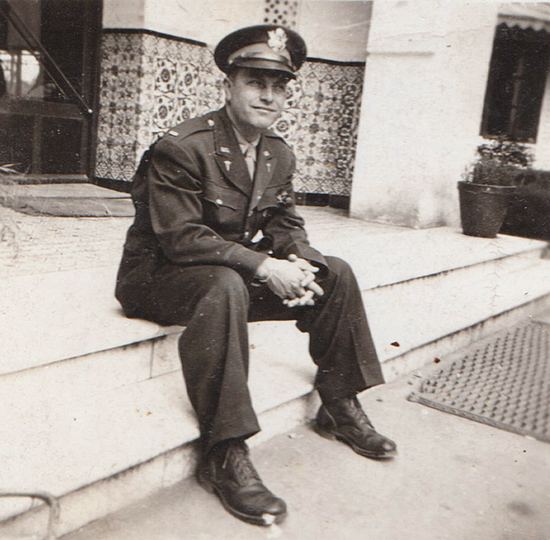
Dr. McKee was born in Durham, North Carolina, the son of Lewis M. (a railroader) and Ada McKee. (Evidentially he did not normally go by Lewis McKee, Jr., based on his military records and gravestone.) Dr. McKee’s grandfather, James McKee, was a Confederate soldier who became a physician after the Civil War. (Interestingly enough, Dr. James McKee later became an educator of African-American medical students at Leonard Medical School at Shaw University in Raleigh. A family member recalled being told that James McKee participated in the Civil War only reluctantly.) Dr. Lewis McKee’s great-grandfather, William H. McKee was also a physician.
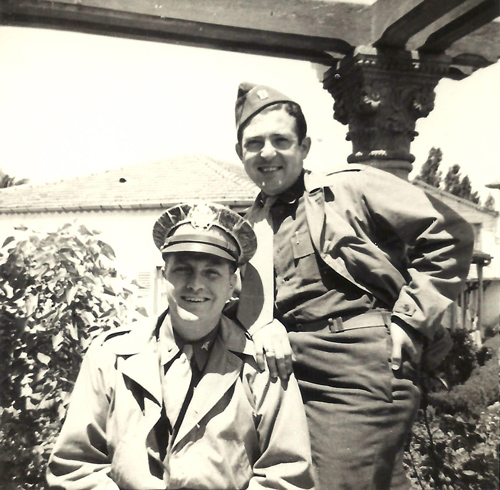
Dr. McKee attended the University of North Carolina and graduated from Temple Medical School, followed by an internship at Watts Hospital in Durham. On May 18, 1931, he married Helen Dickson (1911–1996), with whom he had one daughter. He opened his own practice in Durham in 1934. By the time of the 1940 census, he was working as a physician in Durham. By the time he registered for the draft on October 16, 1940, he was listed as 5 feet, 8 inches (172 cm) tall and weighing 190 lbs. (86 kg) with brown hair and blue eyes.

According to his Department of Veterans Affairs B.I.R.L.S. file, Dr. McKee joined the U.S. Army on July 11, 1942. 1st Lieutenant McKee joined the 32nd Station Hospital at Camp Rucker, Alabama on August 12, 1942. He accompanied the unit overseas to Tlemcen, Algeria. According to Dr. Linn’s 1998 letter to Willard Havemeier, Linn was roommates at the Hotel Transatlantique with McKee, Candler Willis, and Nace Cohen. Based on organizational chart from Dr. Hagelshaw’s collection, as of May or June 1943, Dr. McKee was responsible for Wards C-1, C-2, C-5, and C-11 as well as the Laboratory. He was relieved of the Laboratory duty on August 15, 1943.
A September 25, 1943 letter from nurse Alice Griffin to her family mentioned his departure from the unit:
Another one of our doctors have gone back to the states. He was a swell egg – Lt McKee from N. Carolina. The country just didn’t agree with him & he lost 45 lbs. He was one of the best & liked by all.
An October 26, 1944 story in the Durham Morning Herald announced that Dr. McKee was being promoted to captain. By then he was “chief of the gastro-enterology section” at the station hospital at Camp Butner, North Carolina. He remained at Camp Butner until the end of the war, returning home on terminal leave in November 1945; he left active duty in the U.S. Army effective December 19, 1945. Dr. McKee was still practicing medicine as of December 31, 1971, when he and four other McKee physicians were profiled in a Durham Sun article. Dr. McKee died in Morehead City, North Carolina, aged 84.
Walter Russell Munroe, O-287763 (June 29, 1909 – June 8, 1961)
Captain Munroe was one of 17 officers and 22 nurses from the 46th General Hospital who were attached to the 32nd Station Hospital in Tlemcen, Algeria on September 6, 1943. At the time, he was assigned to the 46th’s Surgical Service. That temporary duty assignment ended on October 22, 1943. Just over a year later, Captain Munroe officially joined the 32nd Station Hospital in Caserta, Italy on November 26, 1944. He was assigned from the 7th Replacement Depot per Special Order No. 310, Headquarters 7th Replacement Depot. He was listed as Ward Officer – General Medicine as of December 31, 1944.
Dr. Munroe was hospitalized at the 32nd Station Hospital on January 7, 1945 and then moved to the 300th General Hospital on January 9. He was transferred to the Detachment of Patients, 300th General Hospital effective January 18, 1945. Munroe’s name was on a list of members of the unit compiled for the 1982 reunion who had lost contact with the rest of the unit, with a last known address of Portland, Oregon.
The only Dr. Walter R. Munroe I could find a record of was born in Seattle, Washington to Walter and Jennie Munroe. He graduated from the University of Washington as well as from University of Oregon Medical School. That makes sense, since the 46th General Hospital—his original unit—was affiliated with the University of Oregon Medical School. He married Ada G. Allman in Multnomah County, Oregon on October 2, 1939. An Ancestry.com family tree states the the couple had one son. After the war, Dr. Munroe was living in Portland when he married Mary Louise R. Whitworth in Stevenson, Washington on August 20, 1959. Curiously, Dr. Munroe’s obituary in The Oregonian (Portland, Oregon) on June 6, 1961 lists him as having “served in Italy with the First Armored Division.” The obituary also stated that he had one son even though the Ancestry.com family tree states that he had a son with each of his wives.
Joseph G. Sorett, O-481209 (likely May 10, 1904 – January 29, 1996)
Dr. Sorett was not listed as being a member of the 32nd Station Hospital as of December 24, 1942, so he probably joined the unit in Algeria sometime during 1943. It was probably the second half of the year, since his name didn’t appear on an organizational chart from May or June 1943.
Captain Sorett was listed as Ward Officer – General Medicine on the December 31, 1943 and May 1, 1944 rosters. He was transferred to the 64th Hospital Train in June 1944. Aside from the 32nd’s sparse records, he the only definite record I found of Dr. Sorett was that he attended a Jewish service in January 1944 with my grandfather and several other members of the 32nd Station Hospital. A family member, Mrs A. Sorett, was listed as living in East Orange, New Jersey.
A possible match was the Joseph Sorett listed on the 1910 and 1920 censuses as being born in Bohemia or Romania to Russian Jewish parents, Hyman and Anna Sorotsky, who eventually changed the family name to Sorett. I found a marriage record for a Joseph Sorett to a woman named Marion in New Jersey in 1947; they apparently had two sons, but I have been unable to confirm that this is the same individual who was a doctor in the 32nd Station Hospital.
Robert Otey Yancey Warren, O-475486 (June 4, 1902 – November 10, 1968)

Dr. Warren was born in Montana. He married his wife Florence in 1927; they had three sons. Dr. Warren graduated from medical school at Johns Hopkins in 1929 and completed his internship there. He began practicing as a pediatrician in Wilmington, Delaware after completing his residency in 1931.
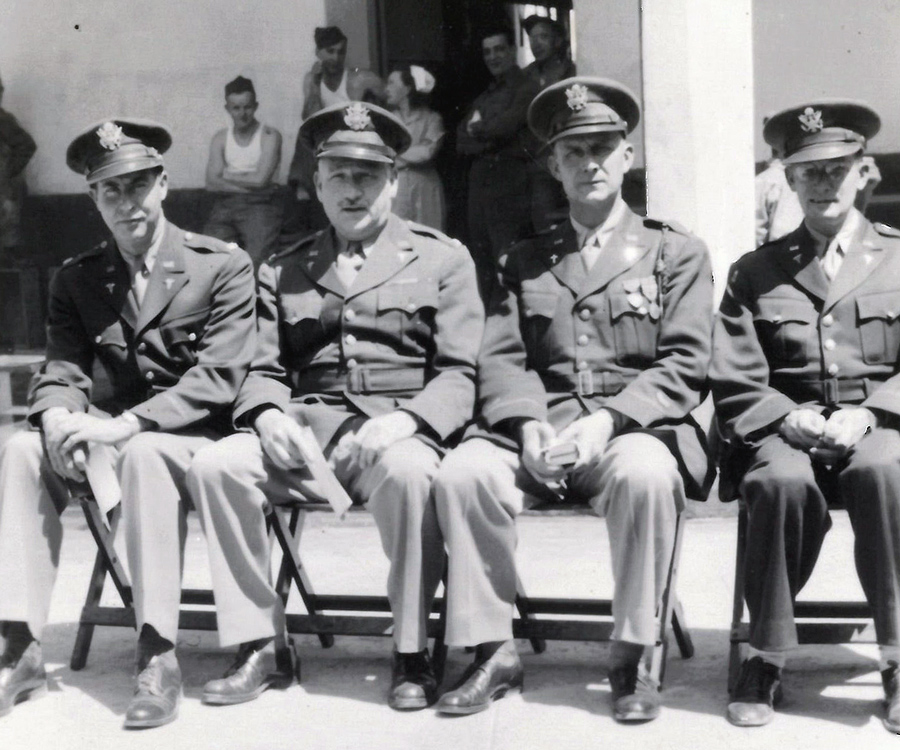
After joining the U.S. Army, Dr. Warren was assigned to Stark General Hospital in Charleston, South Carolina. From there, Major Warren was transferred to the 32nd Station Hospital at Camp Rucker, Alabama on August 15, 1942. According to Captain Lowell E. Vinsant’s journal, Major Warren led the hospital briefly after Colonel Burstein suffered a heart attack (May 12, 1943), until Lieutenant Colonel Hagelshaw took command (May 23, 1943). Major Warren was listed as Chief of Service, Internal Medicine on the December 31, 1943 roster. He was listed as Chief of Medical Service on the May 1, 1944 roster. Dr. Warren was promoted to lieutenant colonel on May 7, 1944.
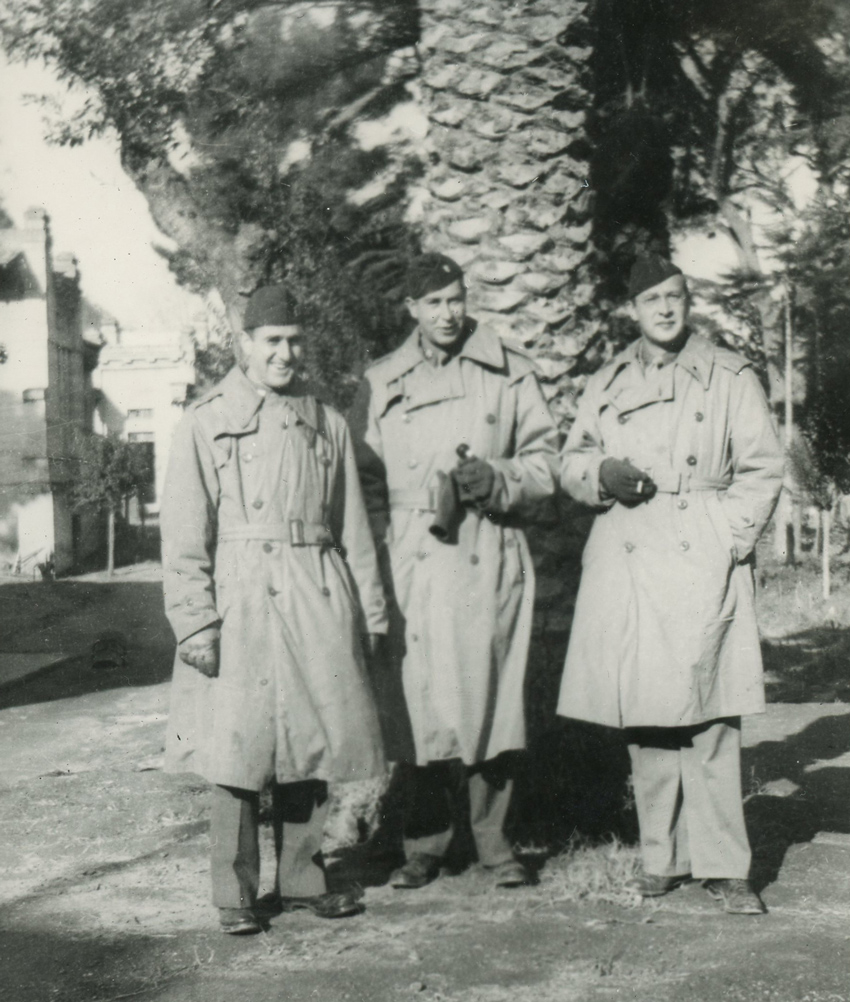
Willard Havemeier recalled of Lieutenant Colonel Warren: “He was a well-liked Officer, and from my perspective as an enlisted man I always thought of him as a credit to his profession and an excellent example of an Officer and a gentleman.”
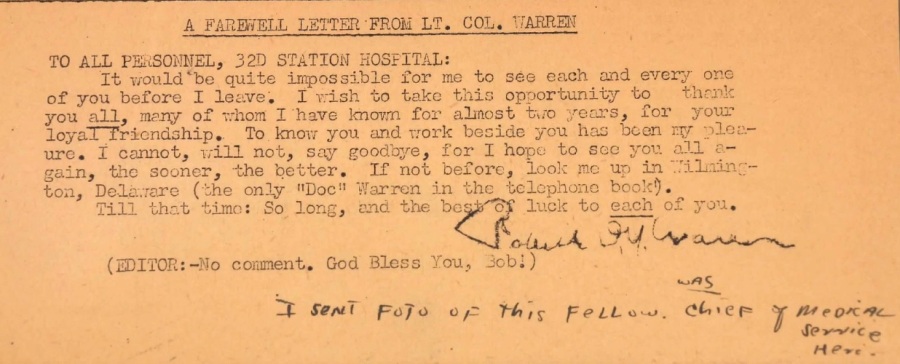
Lieutenant Colonel Warren was transferred to the 38th Evacuation Hospital in August 1944. His emotional farewell letter was printed in The Weakly Reaction, the 32nd Station Hospital’s newspaper, on August 6, 1944:
TO ALL PERSONNEL, 32D STATION HOSPITAL:
It would be quite impossible for me to see each and every one of you before I leave. I wish to take this opportunity to thank you all, many of whom I have known for almost two years, for your loyal friendship. To know you and work beside you has been my pleasure. I cannot, will not, say goodbye, for I hope to see you all again, the sooner, the better. If not before, look me up in Wilmington, Delaware (the only “Doc” Warren in the telephone book).
Till that time: So long, and the best of luck to each of you.Robert O.Y. Warren
According to an April 25, 1945 article printed in the Journal-Every Evening (Wilmington, Delaware), Lieutenant Colonel Warren was Chief of Medical Service in his new unit. The article stated that he received a commendation for his leadership during the evacuation of the hospital during a flood on November 2, 1944. According to the 38th Evacuation Hospital unit history at the WW2 US Medical Research Centre, the hospital was located in Pisa at the time.
Dr. Warren died in Wilmington, aged 66. On November 13, 2019, the Nemours/Alfred I. duPont Hospital for Children held the 50th Annual Robert O.Y. Warren, MD Memorial Seminar.
Last updated December 24, 2020

Dr. Warren was my pediatrician after the war. He probably saved my life. A reminder of the sacrifices made by the WWII generation. Thanks so much for the memories!
LikeLike